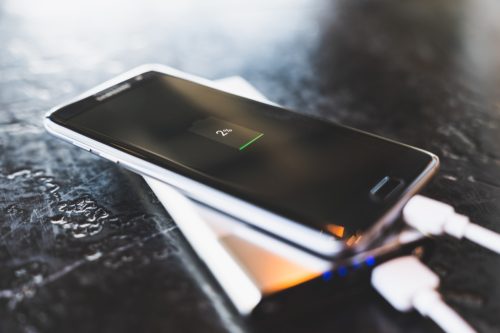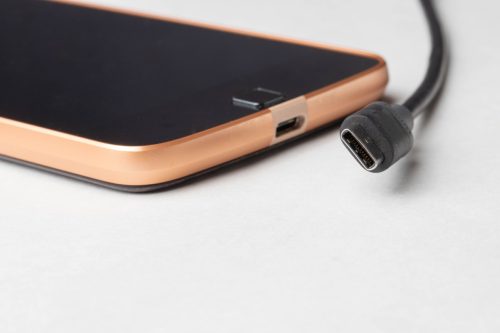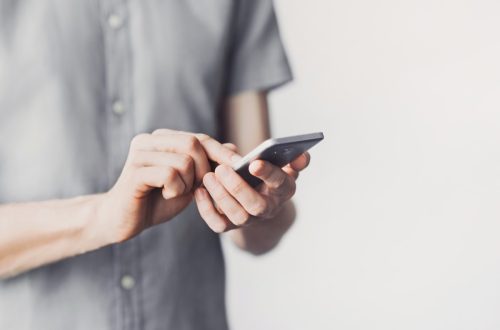Never Charge Your Android Phone This Way, Experts Say

Charging your Android smartphone is a daily necessity—unless you want to face the dreaded dead battery. You might prefer to charge your phone while you sleep and aren’t actively using it, or plug it into your car’s USB outlet on your morning commute. But tech experts have specific recommendations for charging your Android, which include avoiding a very common habit. Read on to find out what you shouldn’t do when plugging in your Android, and how it could be killing your battery.
READ THIS NEXT: If You Have an Android, You’re Now Barred From Doing This on Your Phone.
Android smartphones have a specific kind of battery

Inside your Android—powering your ability to text, snap pictures, or play Candy Crush—is a lithium-ion battery. According to Android Authority, this type of battery has been the first choice for several smartphones, and it offers a whole host of benefits, including durability and low production costs.
But these batteries also have their downsides, particularly as they age and begin to deteriorate, Dignited reports. This deterioration starts when it leaves the manufacturer, and causes batteries to tap out within just two to five years. With that in mind, tech and smartphone experts have tips for what not to do when charging your Android, as you could be killing your battery even faster.
Avoid letting your battery get too low.

If you tend to let your Android battery deplete entirely before you reach for your charging cable, you might want to break this habit. According to tech experts, letting your phone get down to 0 percent is one of the most detrimental moves you can make, because of the type of battery that your Android uses.
“Allowing your phone’s battery to totally deplete to zero isn’t ideal for the device’s long-term health,” Eloise Tobler, smartphone expert of the Wisetek Store, tells Best Life.
“These lithium phone batteries have a finite amount of cycles, meaning that the cell can only go dead and recharge a limited amount of times. When your phone dies, this reduces the number of cycles left, and as a result, the battery is able to hold less charge, shortening its overall lifespan,” she explains.
Try this charging strategy instead.

It works both ways—just as you don’t want to let your battery get too low, you also want to be wary of overcharging your Android, which can cause damage, too.
“In terms of bad charging habits, never leave your phone to idly charge overnight—we’re all guilty of it,” Tobler says. “When you leave your battery constantly charging at 100 percent, you’re stressing the battery by exposing it to higher voltages for a longer period of time.”
Instead of waiting until the last second to charge your Android, experts recommend always having a partial charge, which can be helpful for the lifespan of these lithium batteries. “Charging your battery and keeping it somewhere in that 20 to 80 percent range means you’re subjecting it to relatively low voltages, which may actually prolong the battery’s overall life,” Tobler notes.
It might seem like a hassle to constantly be keeping your phone’s battery within the 20 to 80 percent range, but it will actually save you time and money in the long run. Maintaining your Android’s battery health means you’ll have to replace it less frequently—and if you’re someone who likes to keep your phone for as long as possible, this is a key component to making it last.
For more technology advice delivered straight to your inbox, sign up for our daily newsletter.
Your battery will send you signs if it’s on its last legs.

To hold onto your Android for a bit longer, Brandon Wilkes, tech guru and marketing manager at The Big Phone Store, recommends avoiding “extreme temperatures,” which can damage your phone battery, and performing “regular maintenance,” like calibrating your battery (a process that corrects your Android’s battery information so it can accurately account for power levels).
But if your battery is already on its way out, there are a few things you’ll notice, which might require you to have your Android looked at by a professional.
“There’s a few telltale signs that your battery needs replacing, the first of which being a noticeable, quick drain,” Tobler says. “If your phone isn’t charging when plugged in, you may need a replacement, and if you’re noticing that the battery is quite hot, you definitely need to get the device looked at, as this could be potentially dangerous.”